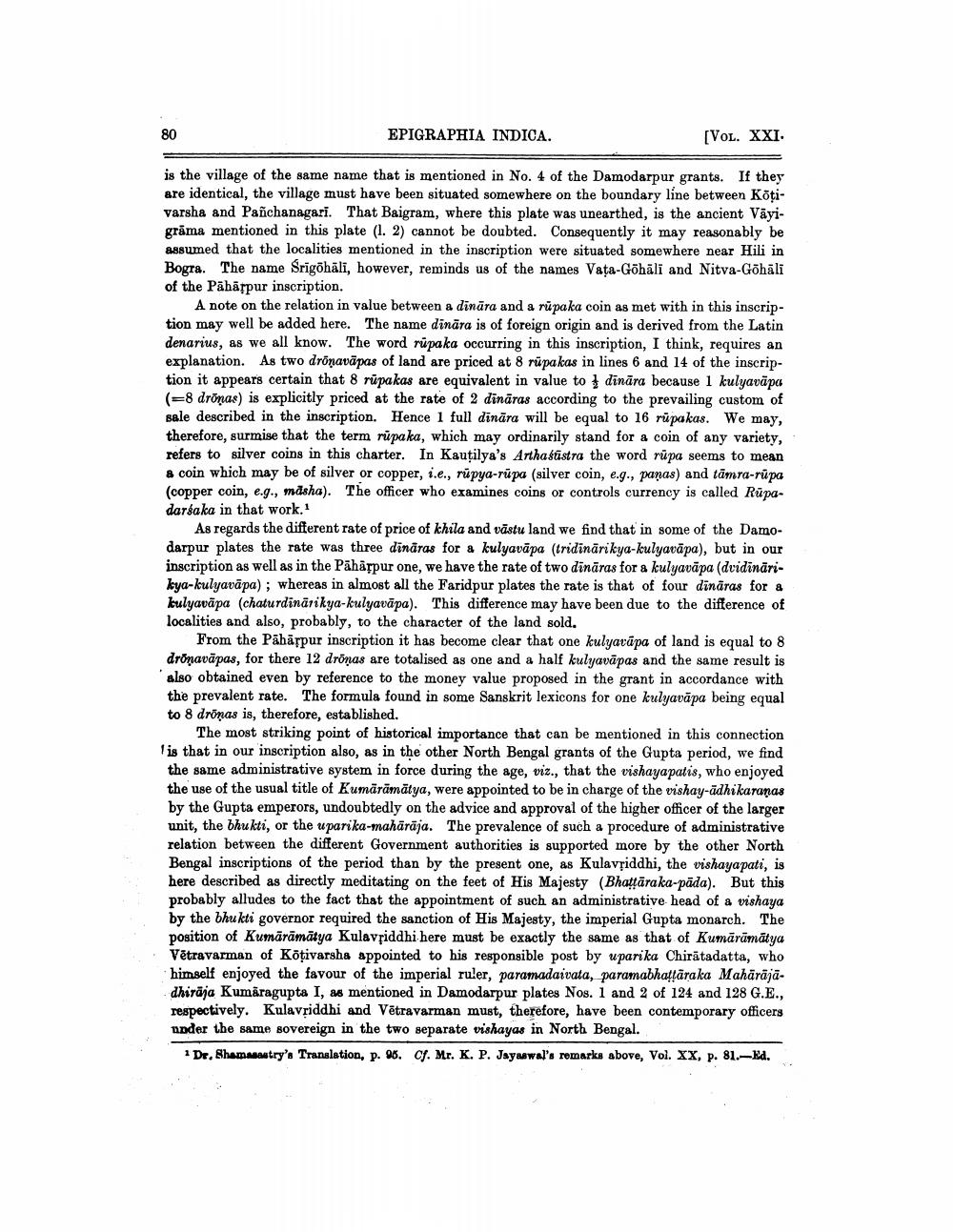________________
80
EPIGRAPHIA INDICA.
(VOL. XXI.
is the village of the same name that is mentioned in No. 4 of the Damodarpur grants. If they are identical, the village must have been situated somewhere on the boundary line between Köțivarsha and Panchanagari. That Baigram, where this plate was unearthed, is the ancient Vāyigrāma mentioned in this plate (1. 2) cannot be doubted. Consequently it may reasonably be assumed that the localities mentioned in the inscription were situated somewhere near Hili in Bogra. The name Srigõhäli, however, reminds us of the names Vaţa-Göhäli and Nitva-Gõhāli of the Pāhāpur inscription.
A note on the relation in value between a dināra and a rūpaka coin as met with in this inscription may well be added here. The name dināra is of foreign origin and is derived from the Latin denarius, as we all know. The word rūpaka occurring in this inscription, I think, requires an explanation. As two drõnavāpas of land are priced at 8 rūpakas in lines 6 and 14 of the inscription it appears certain that 8 rūpakas are equivalent in value to dināra because 1 kulyavāpa (=8 drõņas) is explicitly priced at the rate of 2 dināras according to the prevailing custom of sale described in the inscription. Hence 1 full dināra will be equal to 16 rūpakas. We may, therefore, surmise that the term rūpaka, which may ordinarily stand for a coin of any variety, refers to silver coins in this charter. In Kautilya's Arthastistra the word rūpa seems to mean 8 coin which may be of silver or copper, i.e., rūpya-rupa (silver coin, e.g., panas) and tāmra-rupa (copper coin, e.g., mdsha). The officer who examines coins or controls currency is called Rupadarsaka in that work.
As regards the different rate of price of khila and västu land we find that in some of the Damodarpur plates the rate was three dināras for a kulyavāpa (tridināri kya-kulyavāpa), but in our inscription as well as in the Pähäfpur one, we have the rate of two dināras for a kulyavāpa (dvidinärikya-kulyavāpa); whereas in almost all the Faridpur plates the rate is that of four dināras for a kulyavāpa (chaturdinärikya-kulyavāpa). This difference may have been due to the difference of localities and also, probably, to the character of the land sold.
From the Paharpur inscription it has become clear that one kulyarāpa of land is equal to 8 dronavāpas, for there 12 drönas are totalised as one and a half kulyavāpas and the same result is also obtained even by reference to the money value proposed in the grant in accordance with the prevalent rate. The formula found in some Sanskrit lexicons for one kulyavāpa being equal to 8 drönas is, therefore, established.
The most striking point of historical importance that can be mentioned in this connection is that in our inscription also, as in the other North Bengal grants of the Gupta period, we find the same administrative system in force during the age, viz., that the vishayapatis, who enjoyed the use of the usual title of Kumārāmātya, were appointed to be in charge of the vishay-adhikaranas by the Gupta emperors, undoubtedly on the advice and approval of the higher officer of the larger unit, the bhukti, or the uparika-mahārāja. The prevalence of such a procedure of administrative relation between the different Government authorities is supported more by the other North Bengal inscriptions of the period than by the present one, as Kulavșiddhi, the vishayapati, is here described as directly meditating on the feet of His Majesty (Bhatāraka-pāda). But this probably alludes to the fact that the appointment of such an administrative head of a vishaya by the bhukti governor required the sanction of His Majesty, the imperial Gupta monarch. The position of Kumārāmātya Kulavriddhi here must be exactly the same as that of Kumārümätya Vētravarman of Kötivarsha appointed to his responsible post by uparika Chirätadatta, who himself enjoyed the favour of the imperial ruler, paramadaivata, paramabhattāraka Mahārājā. dhiraja Kumāragupta I, as mentioned in Damodarpur plates Nos. 1 and 2 of 124 and 128 G.E., respectively. Kulavriddhi and Vētravarman must, therefore, have been contemporary officers under the same sovereign in the two separate vishayas in North Bengal.
De, Shammastry'n Translation, p. 46. cf. Mr. K. P. Jayaswal's remarks above, Vol. XX, p. 81.-d.




